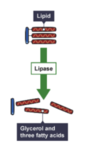human nutrition Flashcards
balanced diet
A balanced diet is a diet in which all the components needed to maintain health are present in appropriate proportions.
The necessary food groups are:
Carbohydrates Proteins Lipids Vitamins Minerals Dietary Fibre Water






There are different types of malnutrition depending on the cause of the imbalance
They include:
Starvation
Coronary heart disease
Constipation
Obesity
Protein Energy Malnutrition

In many countries in the world, droughts, natural disasters, wars and a poor economy can lead to mass malnutrition in large areas of the country
The two types of malnutrition most common in these situations are termed ‘protein energy malnutrition’ (PEM)and they are:Kwashiorkor – caused by a lack of protein in the diet, most common in children under 2.
Often caused by poverty as high protein foods tend to be more expensive and scarcer.
Children suffering from kwashiorkor are always underweight for their age but they often have a swollen abdomen as their diet may contain a lot of carbohydrate
Marasmus – the most severe form of PEM, where there is a lack of both protein and energy in the diet.
People suffering from this have a much lower body weight than normal and look emaciated

Dietary Needs of Different Individuals


Food taken into the body goes through 5 different stages during its passage through the alimentary canal (the gut)
Ingestion – the taking of substances, e.g. food and drink, into the body through the mouth
Mechanical digestion – the breakdown of food into smaller pieces without chemical change to the food molecules
Chemical digestion – the breakdown of large, insoluble molecules into small, soluble molecules
Absorption – the movement of small food molecules and ions through the wall of the intestine into the blood
Assimilation – the movement of digested food molecules into the cells of the body where they are used, becoming part of the cells
Egestion – the passing out of food that has not been digested or absorbed, as faeces, through the anus
Ingestion
he taking of substances, e.g. food and drink, into the body through the mouth
Mechanical digestion
the breakdown of food into smaller pieces without chemical change to the food molecules
Chemical digestion
the breakdown of large, insoluble molecules into small, soluble molecules
Absorption
the movement of small food molecules and ions through the wall of the intestine into the blood
Assimilation
the movement of digested food molecules into the cells of the body where they are used, becoming part of the cells
Egestion
the passing out of food that has not been digested or absorbed, as faeces, through the anus





















